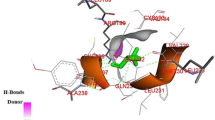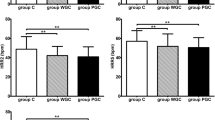Abstract
Objective
To observe abnormalities in heart rate variability (HRV) in diabetic rats and to explore the effects of treatment with Guizhi Decoction (桂枝汤) on cardiac autonomic nervous (CAN) imbalance.
Methods
A radio-telemetry system for monitoring physiological parameters was implanted into rats to record electrocardiac signals and all indictors of HRV [time domain measures: standard deviation of all RR intervals in 24 h (SDNN), root mean square of successive differences (RMSSD), percentage of differences between adjacent RR intervals greater than 50 ms (PNN50), and standard deviation of the averages of RR intervals (SDANN); frequency domain measures: low frequency (LF), high frequency (HF), total power (TP), and LF/HF ratio]. The normal group was randomly selected, and the remaining rats were used to establish streptozocin (STZ)-induced diabetic model. After 4 weeks, the model rats were divided into the model group, the methycobal group, and the Guizhi Decoction group, 9 rats in each group. Four weeks after intragastric administration of the corresponding drugs, the right atria of the rats were collected for immunohistochemical staining of tyrosine hydroxylase (TH) and choline acetyltransferase (CHAT) to observe the distribution of the sympathetic and vagus nerves in the right atrium. The myocardial homogenate from the interventricular septum and the left ventricle was used for determination of TH, CHAT, growth-associated protein 43 (GAP-43), nerve growth factor (NGF), and ciliary neurotrophic factor (CNTF) levels using an enzyme-linked immunosorbent assay.
Results
(1) STZ rats had elevated blood glucose levels, reduced body weight, and decreased heart rate; there was no difference between the model group and the drug treated groups. (2) Compared with the model group, only RMSSD and TP increased in the methycobal group significantly (P<0.05); SDNN, RMSSD, PNN50, LF, HF, and TP increased, LF/HF decreased (P<0.05), and SDANN just showed a decreasing trend in the Guizhi Decoction group (P>0.05). TH increased, CHAT decreased, and TH/CHAT increased in the myocardial homogenate of the model group (P<0.05). Compared with the model group, left ventricular TH reduced in the methycobal group; and in the Guizhi Decoction group CHAT increased, while TH and TH/CHAT decreased (P<0.05). Compared with the model group, CNTF in the interventricular septum increased in the methycobal group (P<0.05); GAP-43 increased, NGF decreased, and CNTF increased (P<0.05) in the Guizhi Decoction group. There were significant differences in the reduction of NGF and elevation of CNTF between the Guizhi Decoction group and the methycobal group (P<0.05). (3) Immunohistochemical results showed that TH expression significantly increased and CHAT expression significantly decreased in the myocardia of the model group, whereas TH expression decreased and CHAT expression increased in the Guizhi Decoction group (P<0.05).
Conclusion
Guizhi Decoction was effective in improving the function of the vagus nerve, and it could alleviate autonomic nerve damage.
Similar content being viewed by others
References
Pop-Busui R, Kirkwood I, Schmid H, Marinescu V, Schroeder J, Larkin D, et al. Sympathetic dysfunction in type 1 diabetes: association with impaired myocardial blood flow reserve and diastolic dysfunction. J Am Coll Cardiol 2004;44:2368–2374.
Vinik AI, Maser RE, Mitchell BD, Freeman R. Diabetic autonomic neuropathy. Diabetes Care 2003;26:1553–1579.
Vinik AI, Ziegler D. Diabetic cardiovascular autonomic neuropathy. Circulation 2007;115:387–397.
Kuehl M, Stevens MJ. Cardiovascular autonomic neuropathies as complications of diabetes mellitus. Nat Rev Endocrinol 2012;8:405–416.
Shotten HR, Clarke S, Lincoln J. The effectiveness of treatments of diabetic autonomic neuropathy is not the same in autonomic nerves supplying different organs. Diabetes 2003;52:157–164.
Li X, Ding SW, Jiang P. A clinical research on Xinhe granules in alleviating endothelial damage in patients with coronary heart disease. J Tradit Chin Med (Chin) 2000;11:661–663.
Jiang P. Clinical study on treatment of Tiaoxin Decoction of immune inflammatory injury in coronary heart disease patients. China J Tradit Chin Med Pharm (Chin) 2005;11:59–60.
Li X, Jiang P, Xu YS, Zhang Y, Jiang YH. Guizhi (Cinnamon Twig) Decoction on spontaneous myocardial collagen remodeling in diabetic rats. China J Tradit Chin Med Pharm (Chin) 2009;8:1068–1071.
Jiang P, Li X, Jiang YH. Effects of Guizhi (Cinnamon Twig) Decoction on spontaneous inflammatory cytokines and myocardial injury in diabetic rats. Chin J Exp Tradit Med Form (Chin) 2010;13:116–119.
Frontoni S, Bracaglia D, Gigli F. Relationship between autonomic dysfunction, insulin resistance and hypertension in diabetes. Nutr Metab Cardiovasc Dis 2005;15:441–449.
Maser RE, Mitchell BD, Vinik AI, Freeman R. The association between cardiovascular autonomic neuropathy and mortality in individuals with diabetes: a Meta-analysis. Diabetes Care 2003;26:1895–1901.
Jung CH, Kim BY, Kim CH, Kang SK, Jung SH, Mok JO. Association of serum adipocytokine levels with cardiac autonomic neuropathy. Cardiovasc Diabeto 2012;13:11–24.
Bootsma M, Swenne CA, van Bolhuis HH, Chang PC, Cats VM, Bruschke AV. Heart rate and heart rate variability as indexes of sympathovagal balance. Am J Physiol 1994;266:1565–1571.
Cerutti C, Gustin MP, Paultre CZ, Lo M, Julien C, Vincent M, et al. Autonomic nervous system and cardiovascular variability in rats: a spectral analysis approach. Am J Physiol 1991;261:1292–1299.
Aubert AE, Ramaekers D, Beckers F, Breem R, Denef C, Van de Werf F, et al. The analysis of heart rate variability in unrestrained rats. Validation of method and results. Comput Method Programs Biomed 1999;60:197–213.
Schaan BD, Dall’Ago P, Maeda CY, Ferlin E, Fernandes TG, Schmid H, et al. Relationship between cardiovascular dysfunction and hyperglycemia in streptozotocin-induced diabetes in rats. Braz J Med Biol Res 2004;37:1895–1902.
Lin YD, Hsu KL, Wu ET, Tsai MS, Wang CH, Chang CY, et al. Autonomic neuropathy precedes cardiovascular dysfunction in rats with diabetes. Eur J Clin Invest 2008;38:607–614.
Lo GP, Careddu A, Magni G, Quagliata T, Quagliata T, Pacifici L, et al. Autonomic neuropathy in streptozotocin diabetic rats: effect of acetyl-L-carnitine. Diabetes Res Clin Pract 2002;56:173–180.
Howarth FC, Jacobson M, Naseer O, Adeghate E. Shortterm effects of streptozotocin-induced diabetes on the electrocardiogram, physical activity and body temperature in rats. Exp Physiol 2005;90:237–245.
Burgi K, Cavalleri MT, Alves AS, Britto LR, Antunes VR, Michelini LC. Tyrosine hydroxylase immunoreactivity as indicator of sympathetic activity: simultaneous evaluation in different tissues of hypertensive rats. Am J Physiol Regul Integr Comp Physiol 2011;300:264–271.
Arvidsson U, Riedl M, Elde R, Meister B. Vesicular acetylcholine transporter (VAChT) protein: a novel and unique marker for cholinergic neurons in the central and peripheral nervous systems. J Comp Neurol 1997;378:454–467.
Bitar MS, Koulu M, Rapoport SI. Adrenal catecholamine metabolism and myocardial adrenergic receptors in streptozotocin diabetic rats. Biochem Pharmacol 1987;36:1011–1016.
Otake H, Suzuki H, Honda T, Maruyama Y. Influences of autonomic nervous system on atrial arrhythmogenic substrates and the incidence of atrial fibrillation in diabetic heart. Int Heart J 2009;50:627–641.
Mabe AM, Hoover DB. Remodeling of cardiac cholinergic innervation and control of heart rate in mice with streptozotocininduced diabetes. Auton Neurosci 2011;162:24–31.
Schramm E, Wagner M, Nellessen U, Inselmann G. Ultrastructural changes of human cardiac atrial nerve endings in diabetes mellitus. Eur J Clin Invest 2000;30:311–316.
Dvorakova MC, Pfeil U, Kuncova J, Svíglerová J, Galvis G, Krasteva G, et al. Down-regulation of vasoactive intestinal peptide and altered expression of its receptors in rat diabetic cardiomyopathy. Cell Tissue Res 2006;323:383–393.
Sung JY, Park SB, Liu YT, Kwai N, Arnold R, Krishnan AV, et al. Progressive axonal dysfunction precedes development of neuropathy in type 2 diabetes. Diabetes 2012;61:1592–1598.
Boer-Martins L, Figueiredo VN, Demacq C, Martins LC, Consolin-Colombo F, Figueiredo MJ. Relationship of autonomic imbalance and circadian disruption with obesity and type 2 diabetes in resistant hypertensive patients. Cardiovasc Diabetol 2011;10:24.
Vinik AI, Maser RE, Ziegler D. Autonomic imbalance: prophet of doom or scope for hope? Diabet Med 2011;28:643–651.
Benowitz LI, Perrone-bizzozero NI. The expression of GAP-43 in relation to neuronal growth and plasticity: when, where, how, and why? Prog Brain Res 1991;89:69.
Aigner L, Arber S, Kapfhammer JP, Laux T, Schneider C, Botteri F, et al. Overexpression of the neural growth-associated protein GAP-43 induces nerve sprouting in the adult nervous system of transgenic mice. Cell 1995;83:269–278.
Carmichael ST. Plasticity of cortical projections after stroke. Neuroscientist 2003;9:64–75.
Korsching S, Thoenen H. Quantitative demonstration of retrograde axonal transport of endogenous nerve growth factor. Neurosci Lett 1983;39:1–4.
Levi-Montalcini R, Angeletti PU. Nerve growth factor. Physiol Rev 1968;48:534–569.
Wang X, Halvorsen SW. Reciprocal regulation of ciliary neurotrophic factor receptors and acetylcholine receptors during synaptogenesis in embryonic chick atria. J Neurosci 1998;18:7372–7380.
Vo PA, Tomlinson DR. Effects of nerve growth factor on expression of GAP-43 in right atria after sympathectomy in diabetic rats. Diabetes Obes Metab 2001;3:350–359.
Yoshioka K, Tanaka K. Effect of methylcobalamin on diabetic autonomic neuropathy as assessed by power spectral analysis of heart rate variations. Horm Metab Res 1995;1:43–44.
Zhang BG, Liang XX, Liu QF. Modern pharmacodynamic study of Guizhi (Cinnamon Twig) Decoction. China J Chin Mater Med (Chin) 2007;32:558–561.
Zhao MF. Analysis of application ideas and mechanism of Guizhi (Cinnamon Twig) Decoction. Jiansu Tradit Chin Med (Chin) 2005;1:39–42.
Cao AM. Five cases of diabetic patients with autonomic neuropathy with classical prescriptions of traditional Chinese medicine. Forum Tradit Chin Med (Chin) 2003;2:8–9.
Author information
Authors and Affiliations
Corresponding author
Additional information
Supported by the National Natural Science Foundation of China (No. 81072962) and the Special Fund of Taishan Scholars Program of Shandong Province (No. 2012-55)
Rights and permissions
About this article
Cite this article
Li, X., Jiang, Yh., Jiang, P. et al. Effect of Guizhi Decoction (桂枝汤) on heart rate variability and regulation of cardiac autonomic nervous imbalance in diabetes mellitus rats. Chin. J. Integr. Med. 20, 524–533 (2014). https://doi.org/10.1007/s11655-014-1861-z
Received:
Published:
Issue Date:
DOI: https://doi.org/10.1007/s11655-014-1861-z




